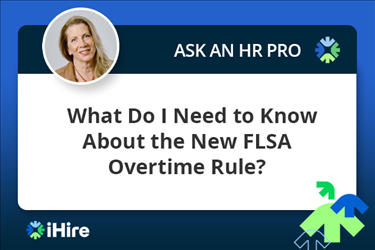- Employer Resources
- |
- Last Updated: July 03, 2023

7 Practical Ways to Reduce Bias in Your Hiring Process
From prejudices, including gender, age, race, religion, and sexual orientation, to smaller discriminations based on attire, accents, and the neighborhood where someone lives, the workforce and hiring process is full of biases. Biases can create a toxic work environment and make individuals feel singled out and excluded, but even more, biases can prevent companies from hiring the best candidate for the job and cause gaps in diversity, equity, and inclusion (DEI).
Biases aren't always intentional or always negative. For example, a recruiter may have the halo effect bias, in which they form a positive impression of a candidate based on one standout quality. However, this can cause them to overlook other necessary skills and characteristics. Whenever you’re making a decision, especially one as important as who to hire, you need to consider all aspects of a candidate's profile.
Companies must implement strategies and practices that actively address positive and negative biases. By actively combating discrimination practices, companies can not only create a fairer and more harmonious workplace but also tap into a wider talent pool, unlocking innovation and driving long-term success.

Seven Practical Ways to Reduce Hiring Biases
Here are 7 practical ways you can reduce bias in your hiring process.
- Modernize your job descriptions
- Use blind hiring
- Create structured interview processes
- Build a diverse interview panel
- Provide bias training to hiring managers and interviewers
- Implement diversity goals
- Use specific software
1. Modernize Your Job Descriptions
The first step in hiring a new employee is to create and post a job description. While this may seem like a simple task, it can also present unconscious discriminatory challenges. You may find your job description uses gender-or other-biased language. For example, if you're looking to hire someone to fill a sales position, use the term salesperson instead of salesman. Using gender-neutral terms helps create a fair balance and encourages people of all genders to apply.
Avoid words like energetic, active, or lively. These words often relate to movement, and applicants may assume that the business is looking to hire someone in a particular age group. Words such as "standing" or "walking" should be avoided as well, as this can deter people with disabilities from applying. For qualifications, try splitting them into different categories, such as necessary, preferred, and nice-to-have. Splitting qualifications into categories will reduce pressure and ensure both the candidates and interviewers understand what's necessary to get the job done.
Finally, you can try offering internships and mentorship programs to underrepresented groups.
2. Use Blind Hiring
Another method for reducing hiring biases is to screen candidates blindly. Blind hiring ensures all personal and identifiable information is omitted so there are no biases to a person's ethnicity, gender, age, education, or personal interests and hobbies. This allows interviewers to focus solely on skills and experience, ensuring the hiring process is fair and that qualified candidates are selected.
But how does blind hiring work? Have an employee assign each candidate a number and then enter their relevant information, such as work experience, skills, and education, into a spreadsheet but leave out any other identifiable criteria. Or, to save time, you can use iHire's Bias Breaker™ feature to do the hard work for you. The feature allows you to blindly screen potential employees' resumes without seeing any personal information that may cause unconscious biases.
3. Create Structured Interview Processes
When interviewing candidates, have a list of standardized questions that you can use to evaluate all candidates equally. These questions should be job-related and focus on specific qualifications or experiences that are important to succeeding in the job.
You can also incorporate skills-based assessments and work samples as part of the evaluation process. This can involve creating a scenario that mirrors real-world challenges they would encounter in the position and assessing how they handle it. It provides a practical way to evaluate their problem-solving skills, decision-making abilities, and job-related knowledge.
4. Build a Diverse Interview Panel
An interview panel can give you better insights into your candidates. Relying on one-on-one interviews may limit the information you gauge from your potential hires. When building your interview panel, you should think about diversity. Whether it's people with disabilities, vastly underrepresented groups, or veterans, try to make your interview panel as diverse as possible.
A diverse interview panel can gauge how potential employees interact in group situations and will allow you to showcase a diverse workplace culture. This type of interview process allows you to gather information and hear differing opinions on how your candidates fare.
Using multiple interviewers will also reduce the risk of forming unconscious biases.
Register Today to Start Utilizing Blind Hiring Tools
5. Provide Bias Training to Hiring Managers and Interviewers
Ensure that you have provided your hiring managers and interviewers with discrimination and bias training. When trained properly, your interviewing team, hiring managers, and even employees should be able to recognize their own unconscious biases before they are an issue.
Hiring without bias allows interviewers to enhance their interviewing abilities, provide better feedback to candidates, improve hiring efficiency, and ultimately boost job satisfaction, employee reputation, and company credibility.
6. Implement Diversity Goals
Diversity goals can help guide you and your organization in implementing diversity throughout your office, and through the interview processes as well. It'll also help steer interviewers and hiring managers away from their own biases and improve DEI efforts.
Goals can help track and measure monthly, quarterly, or yearly progress. It can also help identify and resolve pain points, such as where your company may be failing in certain diversity or discrimination.
7. Use Specific Software
Finally, if you're struggling to know where to begin or have issues squashing all biases, you can implement software that can help you train and keep track of biases. For example, you could try using iHire's Bias Breaker feature to reduce hiring biases.
With iHire's Bias Breaker feature, you can implement blind hiring techniques to focus on finding the best candidate for the job. The feature allows you to automatically hide candidate names, photos, and other details, leaving you with access to information that truly matters. Hiding irrelevant information can then help you avoid unconscious biases.
Software like this feature prevents discrimination, improves DEI efforts, and creates a positive work experience for all involved, including potential hires and current employees.
Preventing unconscious biases is important and necessary. Not only will you improve your DEI efforts and remain legally compliant against discrimination laws, but you'll also create a better work culture for your company. The practical tips in this article can help you improve your diversity and reduce biases in your hiring process. If you still need help, don't forget to use iHire's Bias Breaker feature for blind hiring techniques that will help prevent hiring biases during interview processes.




